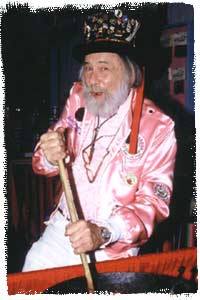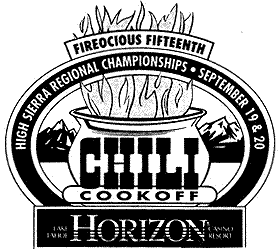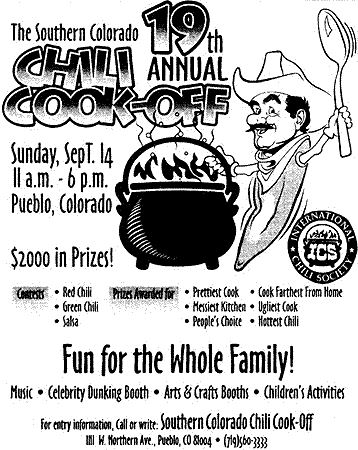by Dave DeWitt
|
Part 8: Cookoff Chilis, ICS-Style
|
Recipe: ICS-Style Chili |
The International Chili Society claims to be largest food contest and festival organization in the world–and that is probably true. According to the ICS website at www.chilicontest.org, “In 2000 over 300 chili cookoffs were held with over one million people tasting, cooking, judging and having a great time. ICS sanctioned cookoffs include three categories: Red (traditional red chili), Chili Verde (green chili) and Salsa. The ICS annually crowns a World Champion in each category.”
ICS–A History, Maybe
In 1989, International Chili Society director Jim West and historian Ormly Gumfudgin teamed to write a brief history of ICS that appeared in The Whole Chile Pepper magazine. What follows here is based on their work and our research.
|
|
ICS Historian Ormly Gumfudgin Cooks Chili
|
The International Chili Society was booted out of Texas in 1974 and reborn in California. Here’s how it happened. During the 1974 cookoff, C. V. Wood and Carroll Shelby flew a network TV crew into Terlingua to cover the festivities. Of course, it was only natural that the media people would interview the people they had traveled with, but Frank Tolbert didn’t like it one bit. After standing around on the sidelines and not receiving any attention from the TV crew, he got mad. In a letter to Wood and Shelby, he invited ICS to take the World’s Championship Chili Cookoff to California and “save the freight.” So they did. It was as simple as that.
The most vital item on the agenda was to decide where it could be held so there would be a sufficient area for the thousands of people we expected. ICS needed hotels, an area for recreational vehicles, a location with the charm of a ghost town like Terlingua, plus many other details. After much searching, Tropico Gold Mine was selected. It’s located three miles west of Rosamond in the Mohave Desert. One other little detail was that ICS trademarked the phrase “World Championship Chili Cookoff.”
The first Championship Chili Cookoff held in California was twice as big as expected–about 20,000 people attended. Maybe some of them were star-struck by our celebrity judges: William Conrad, Robert Mitchum, Ernest Borgnine, Peter Marshall, Dale Robertson, and John Derek. The “Miss Chile Pepper” was Diana House, who went on to spice up Playboy magazine–but that’s another story.
|
|
Logo for an ICS Cookoff, 1992
|
Meanwhile, back in Texas, Frank Tolbert was busy organizing the Chili Appreciation Society International and promoting the Terlingua cookoff. Although relations with the two societies seemed to be “heated,” they were in constant communication with Frank.
Early in 1976, ICS began to get really organized by finding corporate sponsors. Pepsi, Budweiser, Hunt-Wesson, Tabasco Brand, the American Spice Trade Association, and Tequila Sauza came on board to help raise money for various charities. By 1977 the turnout at Tropico Gold Mine for the championship exceeded 35,000. That year Tommy Lasorda, Leslie Uggams, Andy Granatelli, and Bobby Unser were added to the celebrity judging staff, and by the end of the fourth championship, over $50,000 had been raised for charity.
Cash prizes were growing as well. In 1978, the World’s Champion Chili Cook, LaVerne “Nevada Annie” Harris, picked up $14,000–which wasn’t shabby for three hours of cooking. That year ICS started its official publication, Chili.
In 1980 the Tropico Gold Mine was sold lock, stock, and barrel, as the saying goes. The old Paramount Ranch in Agoura was chosen as the new site, but the World Championship Cookoff was eventually moved back to Tropico.
The 1988 Championship was held on October 30th in Tropico with over $35,000 in cash prizes and awards. Since 1975 ICS has raised over $10 million for charities and non-profit organizations. There are nearly 15,000 members world-wide and sanction about 350 cookoffs every year with nearly 10,000 contestants and 5000 judges. Obviously, chili cookoffs today are no longer off-the-wall events, but rather viable fund raising efforts.
|
|
Ad for Typical ICS Cookoff
|
In addition to raising money, ICS also has a lot of fun, which is demonstrated by some of the events at the Tropico Gold Mine. In 1988, the Tulsa, Oklahoma, Jaycees built the World’s Largest Pot of Competition-Style Chili. The 750 gallons of chili was made with 75 pounds of bacon, 3,000 pounds of chili-grind meat, 1,500 pounds of onions, 1,200 cloves of garlic, nearly 30 pounds of spices–and, of course, over 50 pounds of fresh chiles. The concoction, based on a recipe called “Chili from Hell,” was served to more than 20,000 chiliheads at Tropico in a benefit for the St. Jude’s Children’s Hospital in Memphis.
In 1992, the 26th annual World’s Championship Chili Cookoff was moved to Rawhide, an 1880s western town located in Scottsdale, Arizona. The following year, the championship moved to Reno, Nevada.
The Roving Chili Pot
In an effort to revive the Chili Bill that was introduced into Congress in 1984 to make chili America’s official food, the ICS and Hyundai Motor America teamed up in 1993 to move a 300-pound copper chili pot from Washington, D.C. to their World’s Championship Chili Cookoff in Reno, Nevada. The pot was mounted on a motorized stagecoach–which was the first stagecoach to travel across the country since the late 1800s. Jim Lotito did the driving and Ormly Gumfudgin rode shotgun.
Chiliheads pledged ten dollars for every mile the stagecoach traveled and for their pledge they had a chance to win a Hyundai automobile. The stage with the chilipot arrived in Reno on October first–just in time for the championship cookoff.
ICS Procedures and Hints
In 1980, the legendary C.V. Wood (1920-1992) wrote an article on how to judge a chili cookoff. “There are no absolute guidelines on how each judge will or should make the winning selections,” he wrote. But he did offer some major characteristics for winning chili:
-
Good chile pepper taste (“not to hot, not too mild”).
-
Good texture of the meat (“not too tough, not too mushy”).
-
Good consistency (“not too thick, not too thin”).
-
Good blend of spices.
-
Good aroma (a personal preference).
Interestingly enough, Wood wrote: “Color has little to do with a good bowl of chili.” Later cooks disagreed with that comment. Wood’s final estimation of the best way to choose a winning bowl was “If I’m only going to have one type of chili for the rest of my life, which bowl on this table would I choose?”
Here’s some advice from Tom Valentine, who wrote about how to get the most out of a chili cookoff in the early issues the ICS publication, Chili magazine.
-
A chili team can have no more than four members–“The head cook and three elves.”
-
Everything for chili must be prepared on-site. Pre-chopped ingredients such as onions are not permitted, but canned chiles and tomatoes are allowed.
-
Each contestant must cook at least a gallon of chili.
-
Don’t try to be exotic. “Carrots and weiners and saffron and turnips do not impress chili-conditioned palates.”
-
Forget using sugar. “It’s for sissies,” wrote Tom.
-
“Cumin can make or break a superior bowl of chili.”
-
Judges usually rate 60 percent on flavor, 30 percent on texture, and 10 percent on consistency.
|
|
Cover of the ICS Magazine, Chili
|
Additionally, Randy Robinson, the 1991 World’s Champion, offered the following sage advice (no, don’t put sage in your chili).
Use a recipe and keep notes. Randy found it hard to believe that many cooks just “throw together” their chili. Without a recipe, there is no way to repeat success even if they happen to win. “Without a basic recipe and past notes to guide you,” he wrote, “you can’t hope to address the consistency question.”
-
Chili that looks good is bound to taste better. He recommended a “combination of finely cubed (1/4 inch) and coarsely ground meat.
-
Strive for “no flaws” chili. That means, according to Randy, “no unusual, overbearing, or distracting flavors.” The blend of seasonings should be “balanced, harmonious, and complex.”
-
“Know thy Jury.” Randy does his research and visits the favorite chili parlor in a town with a cookoff to determine “everyman’s taste” that the judges will be looking for.
-
To perfect your chili, “practice, judge, and kibbutz.” Randy advised: “The fastest way to learn how to win is by judging chili and stealing secrets from good chili cooks.”
ICS Championship Recipes?
Originally, when we planned the book, Hot & Spicy Chili, from which this project is excerpted, we intended to include recipes from the cookoffs of both the major associations. So we retained some chiliheads to scour the cookoffs and collect recipes from winning cooks–and good recipes from cooks who weren’t fortunate enough to win major prizes. We had great luck with the CASI-sanctioned cookoffs and the Behind the Store competitors. But we ran into a dead end with the ICS.
We wrote to Jim West, then ICS director, requesting permission to reprint some winning ICS recipes that had already been published in their own publications. At first we received no response. Finally, after a phone call to the ICS offices, we were faxed a letter from Edward A. Sokolski, the attorney who represents the ICS for patent, trademark and copyright causes.
“The International Chili Society,” he wrote, “has written agreements with all competitors in its chili cookoffs which provides for the assignment of exclusive rights to the publication of any recipe used in the competition. Rights to publish such recipes have already be committed by my client and therefore permission for you to publish them cannot be granted.”
We warned you that the chili world could be downright contrary. In light of Mr. Sokolski’s letter, we were afraid to publish any recipe associated with an ICS-sanctioned event, so we have not knowingly done so. Instead, we offer a single recipe, ICS-Style Chili, which was created by us. If readers wish to find ICS competition recipes, we suggest clicking on http://www.chilicookoff.com/Recipe/Recipe_Home.asp or looking in the Official Chili Cookbook, by Martina and William Neely, which is listed in our bibliography.
Meanwhile, here is our version of an ICS winning chili.
Since this chili is our own creation and has never been entered in any ICS-sanctioned cookoff, we are permitted to publish it here. It utilizes, however, many of the ingredients and techniques common to ICS-style chilis.
-
3 pounds sirloin steak, cut into 1/4-inch cubes
-
1/4 cup vegetable oil
-
1 cup chorizo sausage
-
1 large onion, minced
-
3 cloves garlic, minced
-
1 stalk celery, minced
-
2 cups beef broth
-
2 cups tomato sauce
-
1 12-ounce bottle Corona beer
-
1/4 cup New Mexican red chile powder (your choice, hot or mild)
-
3 tablespoons chili powder (your choice)
-
½ cup diced New Mexican green chiles
-
1 tablespoon cumin
-
2 teaspoons Mexican oregano
-
Salt, white pepper, cayenne, cumin, and brown sugar, to taste
Saute the steak in the oil in a skillet until lightly browned. With a slotted spoon, remove the steak and reserve. Add the sausage to the same skillet and fry for 5 minutes and remove with the slotted spoon and reserve. Add the onion, garlic, and celery to the oil and saute until the onions are soft. Remove them with the slotted spoon and reserve.
Transfer the steak, sausage, and onion-garlic-celery mixture to a chili pot or Dutch oven. Add the beef broth, tomato sauce, and beer and bring to a simmer. Cook for 1/2 hour.
Add the New Mexican chile powder, your choice chili powder, green chiles, cumin, and oregano, and simmer, uncovered for 1 hour, stirring occasionally.
The next step is the most difficult. Taste the chile and add salt, white pepper, cayenne, cumin, and brown sugar to make the chili perfect. Simmer an additional 15 minutes.
Yield: 6 servings
Heat Scale: Medium
Chili Cook’s Hints: Experiment with other spices to make your chili unique. Some suggestions are: 1/4 to ½ teaspoon of paprika, coriander, cilantro, sage, and basil. You also might want to draw attention to your chili by floating an habanero chile on top, but omit the cayenne and take care that the habanero does not burst!









